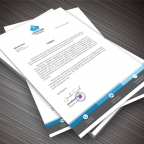What are the main elements of the business letterhead?
The first major element of the business letterhead is your business’ branding. This includes your logo and business name. Always use the logo and business name that clients dealt with. For example, the letter is coming from X employee at Y company, not “employee name”. If the letterhead includes the name of the employee, indicate their role in the organization. The customer is more likely to respond to a letter that comes from “Mr. A, Chief Legal Officer of Firm X” than a random collection notice from an unfamiliar name. A letter coming from the CEO or founder of a firm will be responded to more often than a generic letter that seems to be automatically generated or sent by an underling. However, the business letterhead design must always include your logo. Whether this is the design on your website, employee uniforms or company trucks, it links the letter to your firm and improves the odds they’ll respond to it immediately.
The second element of the business letterhead is the contact information. The letterhead should include the business’ mailing address and phone number at a minimum. Fax numbers are only required if you expect a percentage of letter recipients to fax something back. Email addresses should only be included if the emails sent would be properly routed to those who sent the letter. For example, collection notices shouldn’t direct someone to email a generic [email protected] address. You may not want to send a collection letter that tells people to email or call the CEO, either. This is why company letterhead tends to be generalized, suitable for every person in the organization, unless they’re in senior leadership.
Pre-printed introductions come off as fake, while pre-printed footers can hurt you. For example, a pre-printed “sincerely” or “thanks for your business” on the bottom of the letter undermines the collection notice you printed above it. Note that you don’t want to pre-print anyone’s signature on letterhead, since this could be used to fake their signature elsewhere.
When should you update your business letterhead?
Some businesses are reluctant to invest in company letterhead because it needs to be replaced periodically. Company letterhead must be replaced when you’ve updated your logo, since this keeps your branding consistent. That increases trust in your brand. Business letterhead should change when the name of your business changes. You don’t want the business name to change because of the impact this has on your brand. However, it is inevitable if a partner joins or leaves the firm, changing its legal name and all related documentation.
Company letterhead absolutely must change when your contact information changes. If your area code changes, the phone number on the old letter head is now incorrect. Striking through the old area code and writing a new one is seen as sloppy, and you can’t guarantee this happens to every letter sent out to customers. Business letterhead must change when your business moves. After all, your mailing address has changed. Consider getting new letterhead specific to each branch or store location, unless you’re going to send all correspondence to the main office.
Having your own business letterhead is an indication that you’re in a leadership role. However, this means you have to print new business letterhead when someone is promoted, demoted, retired or fired.

